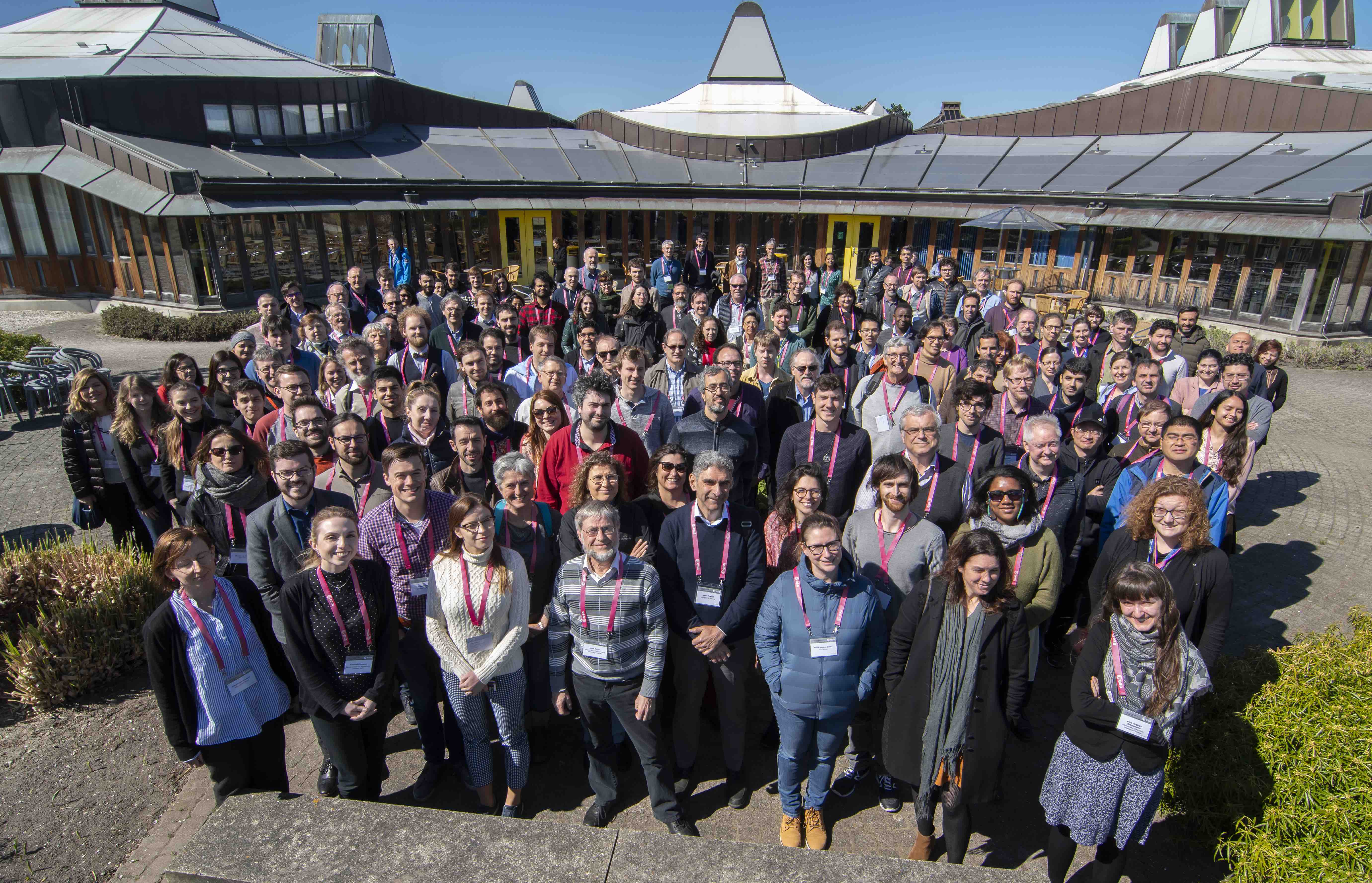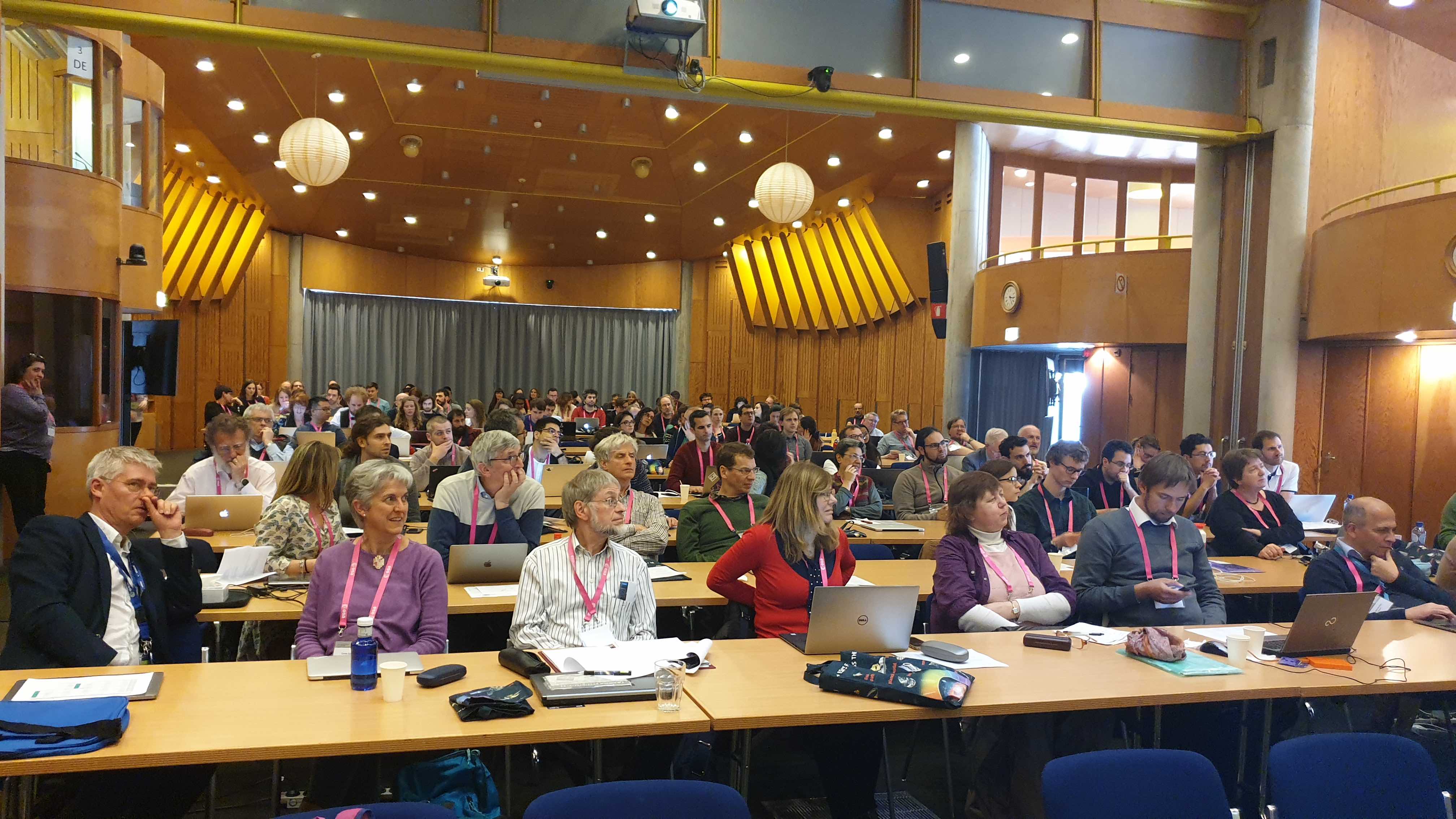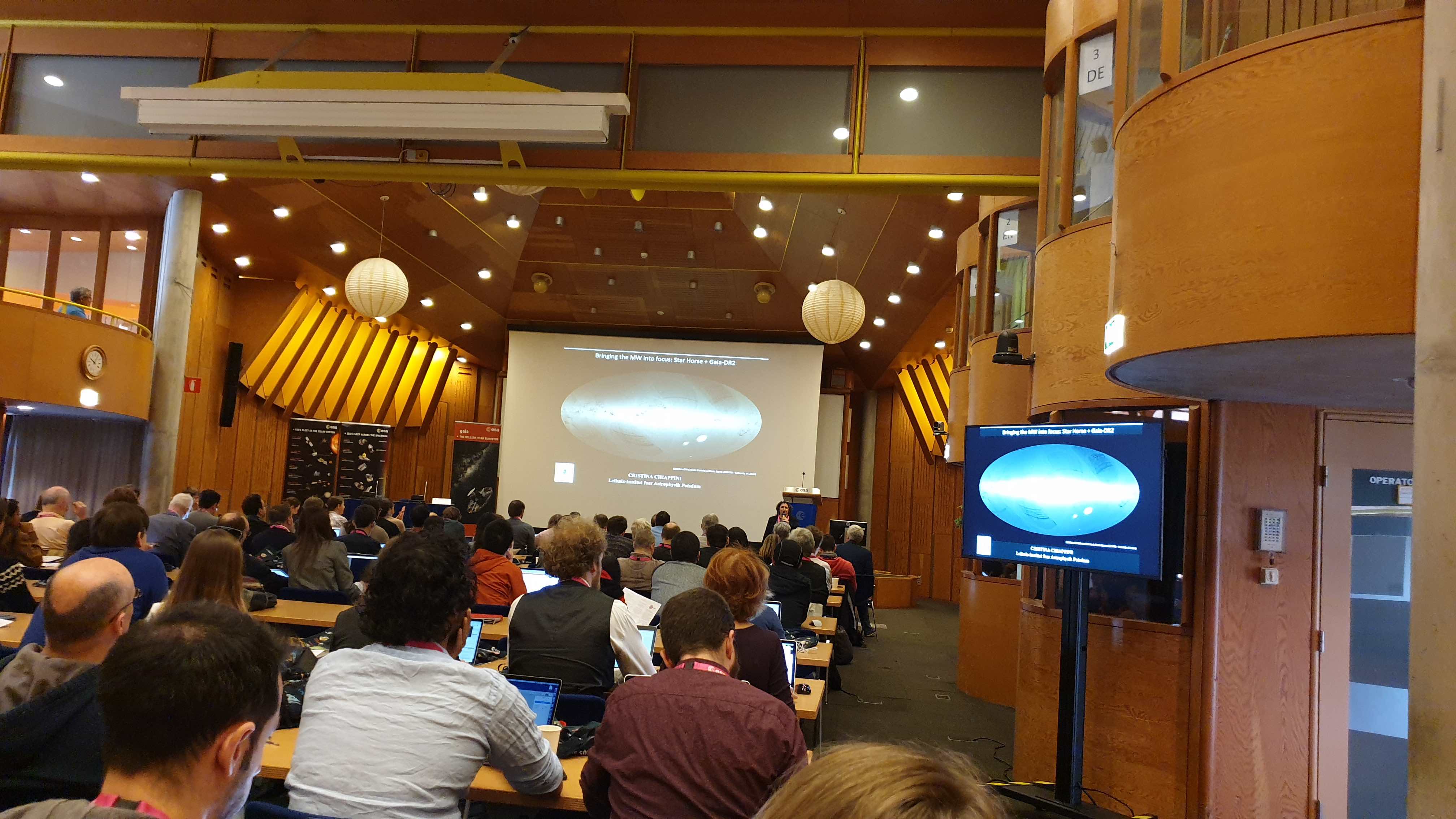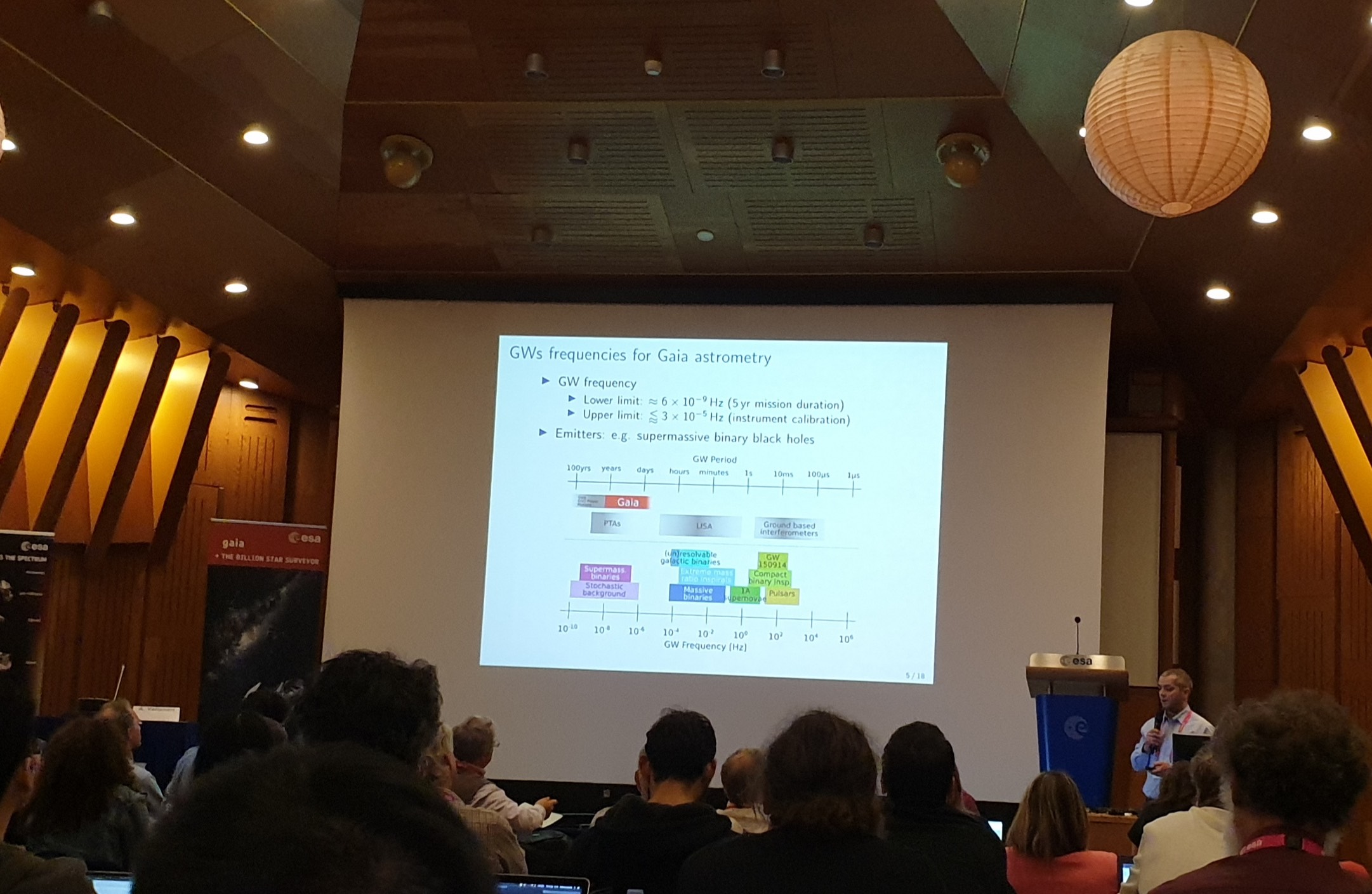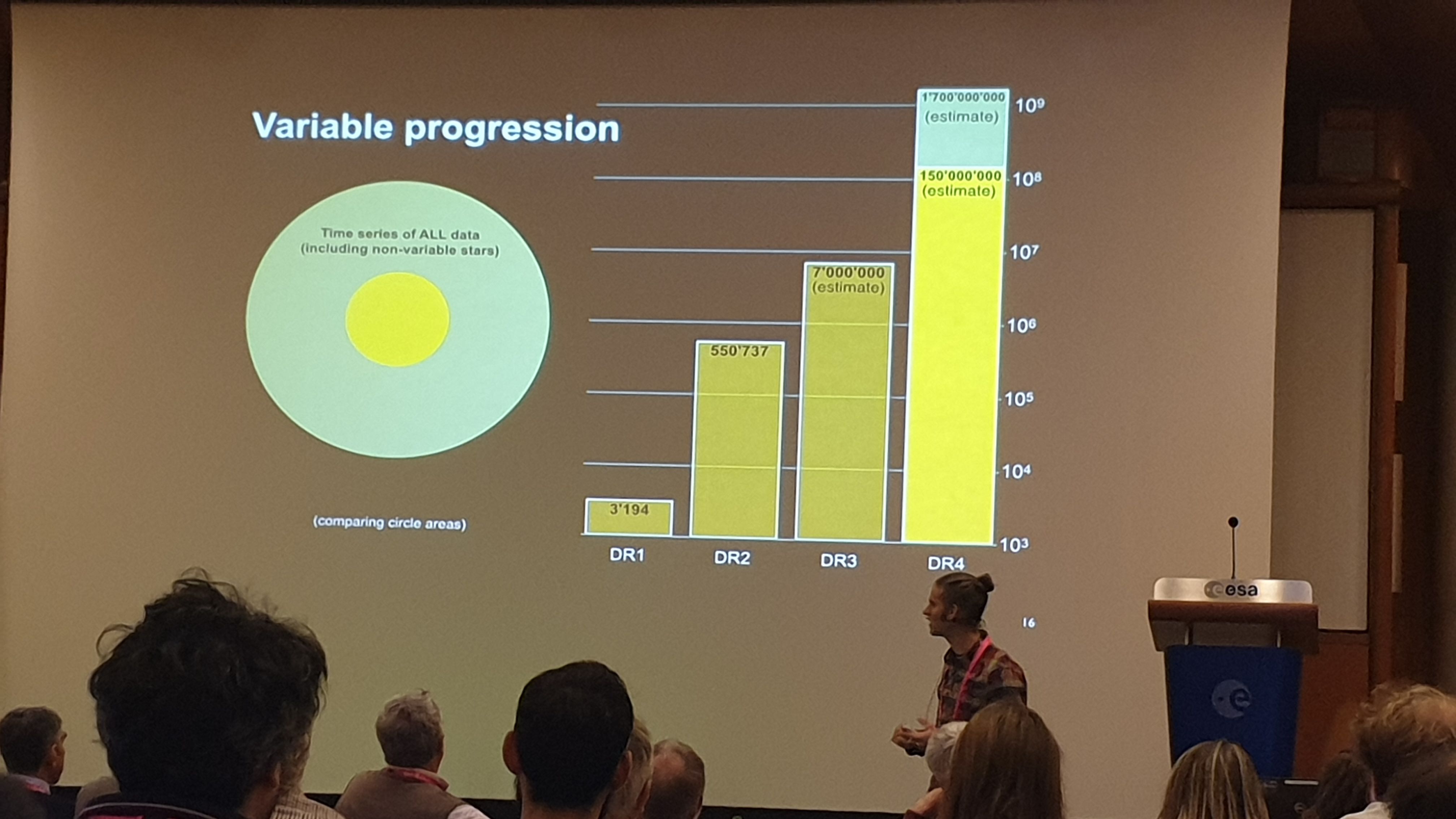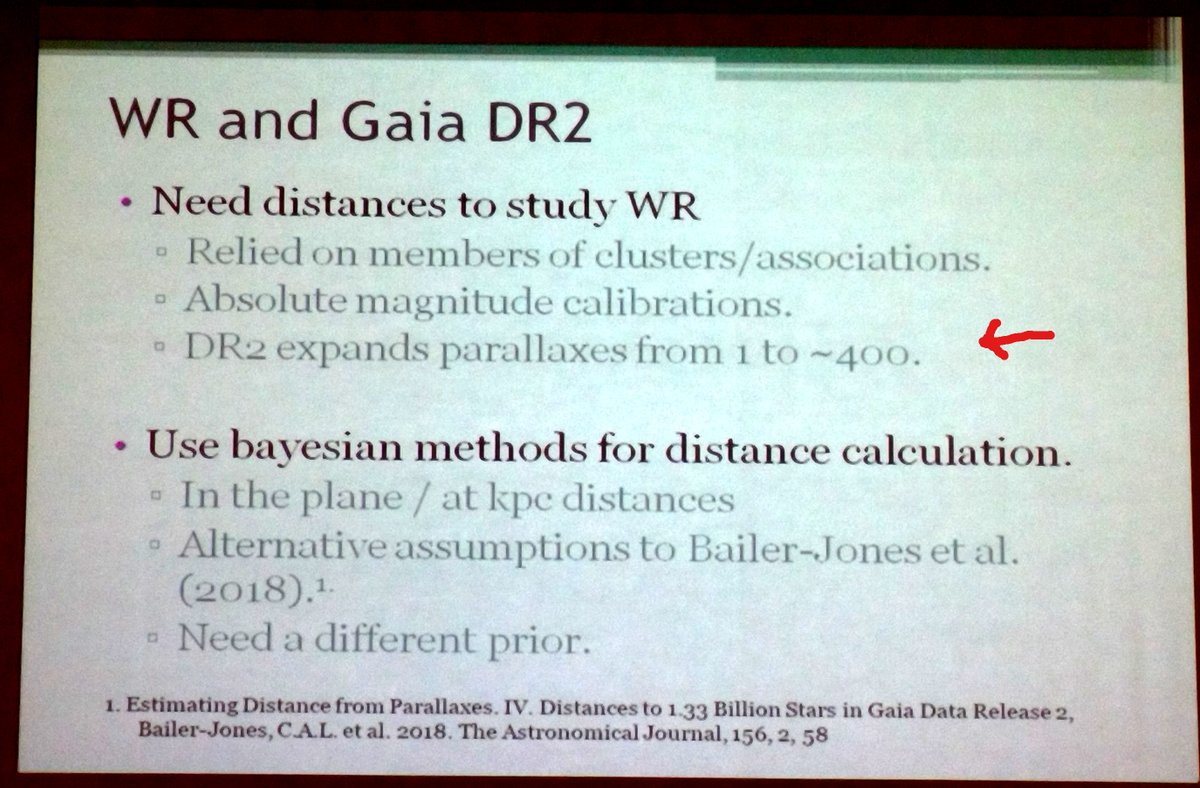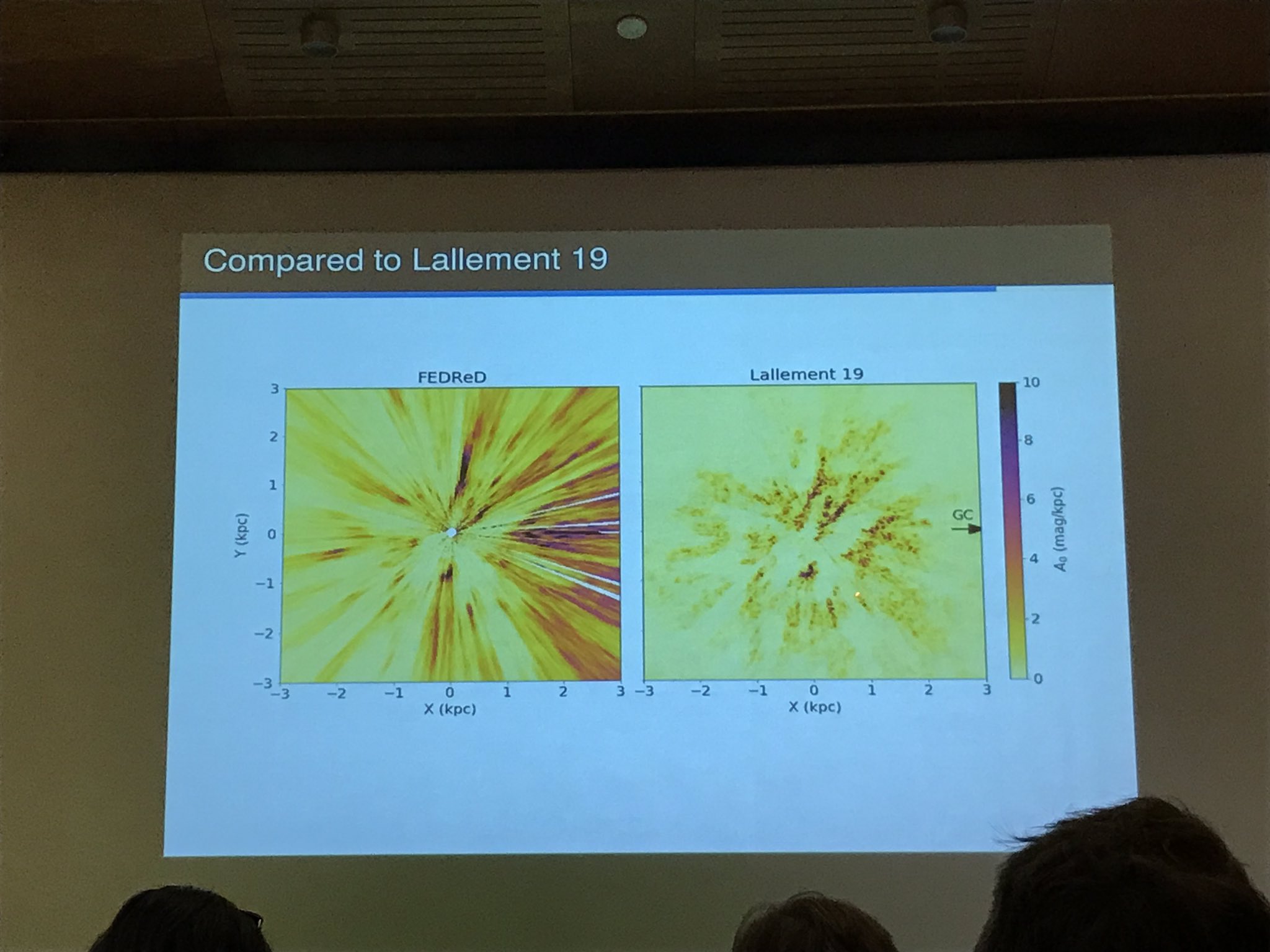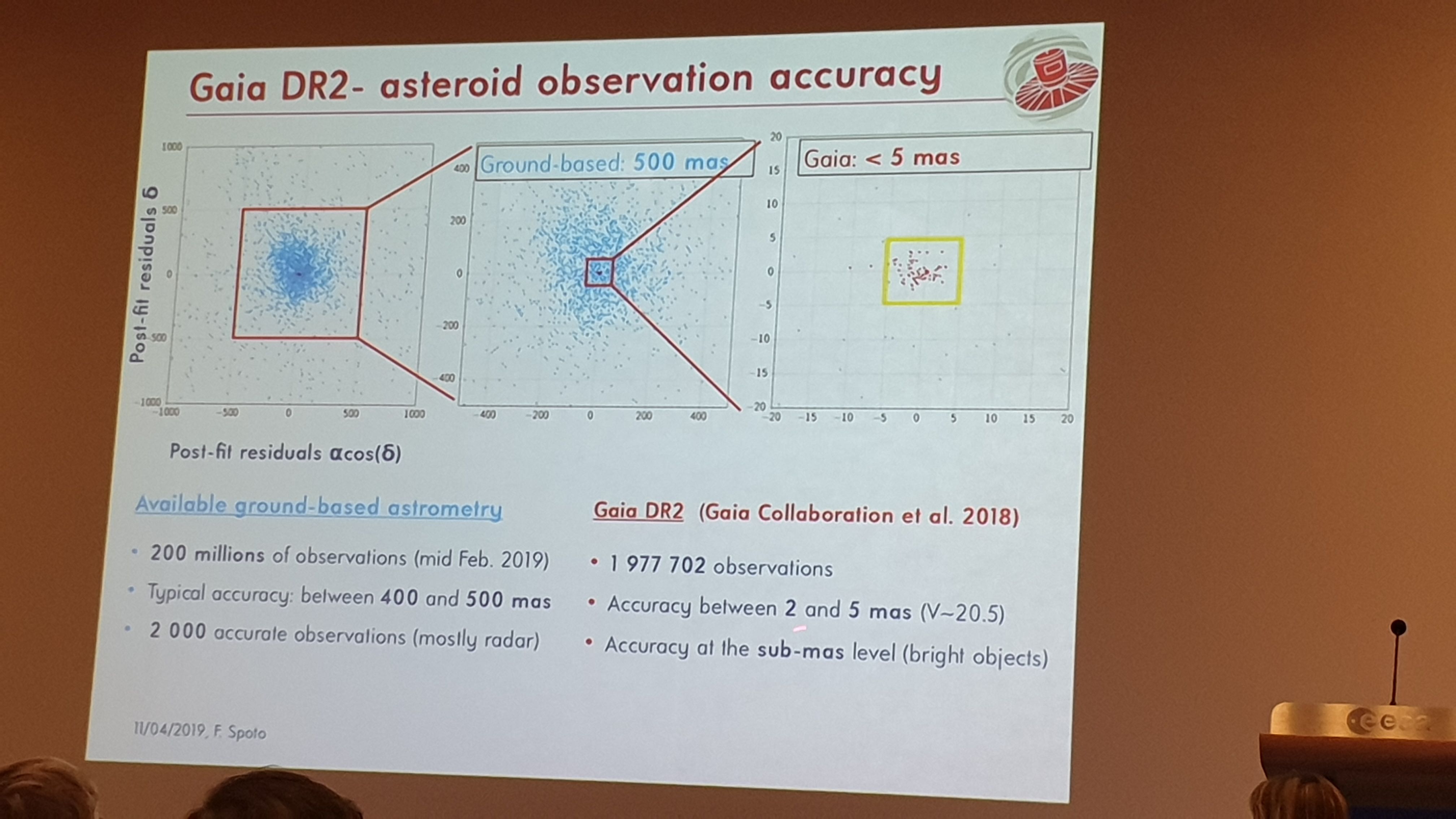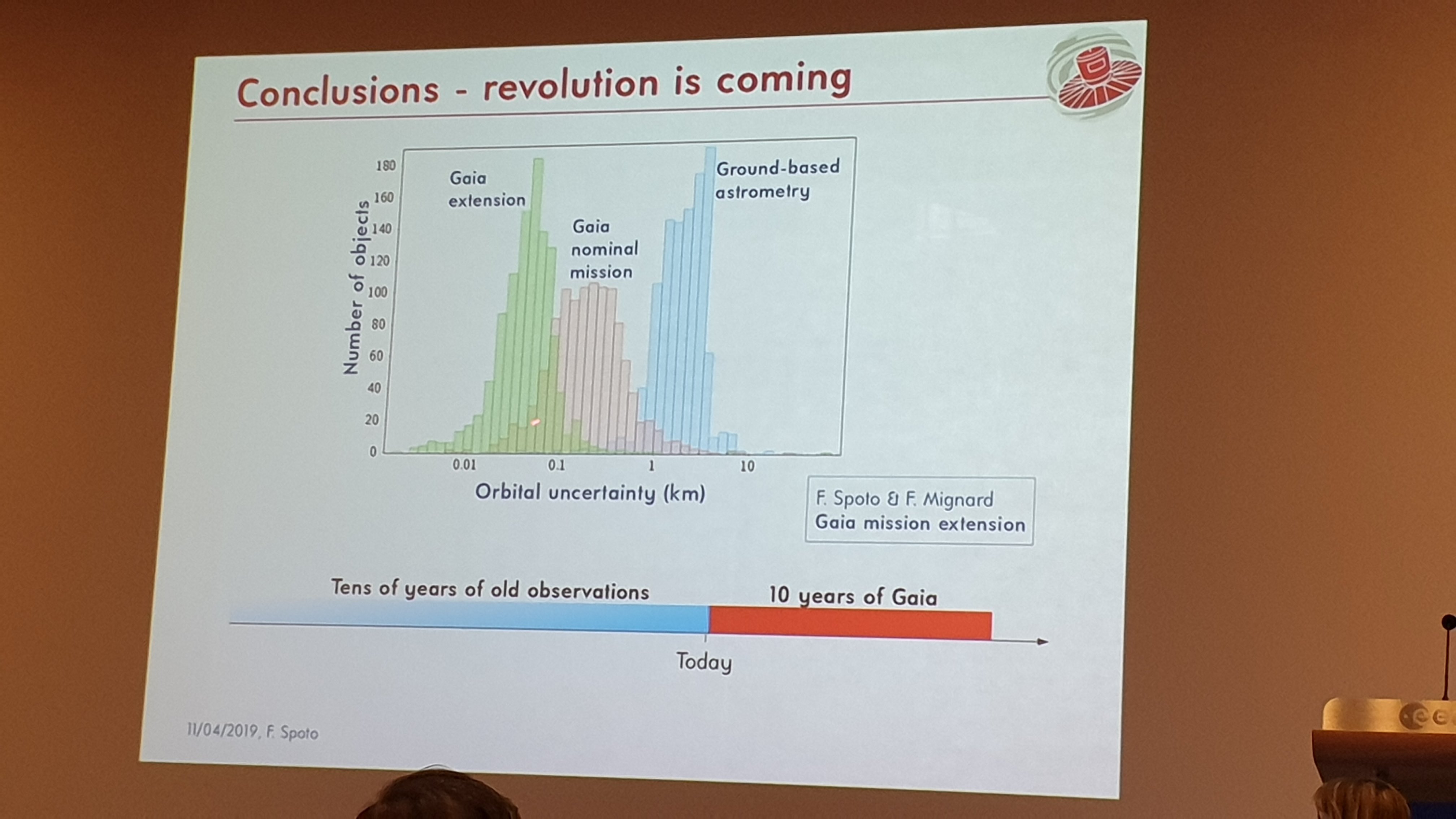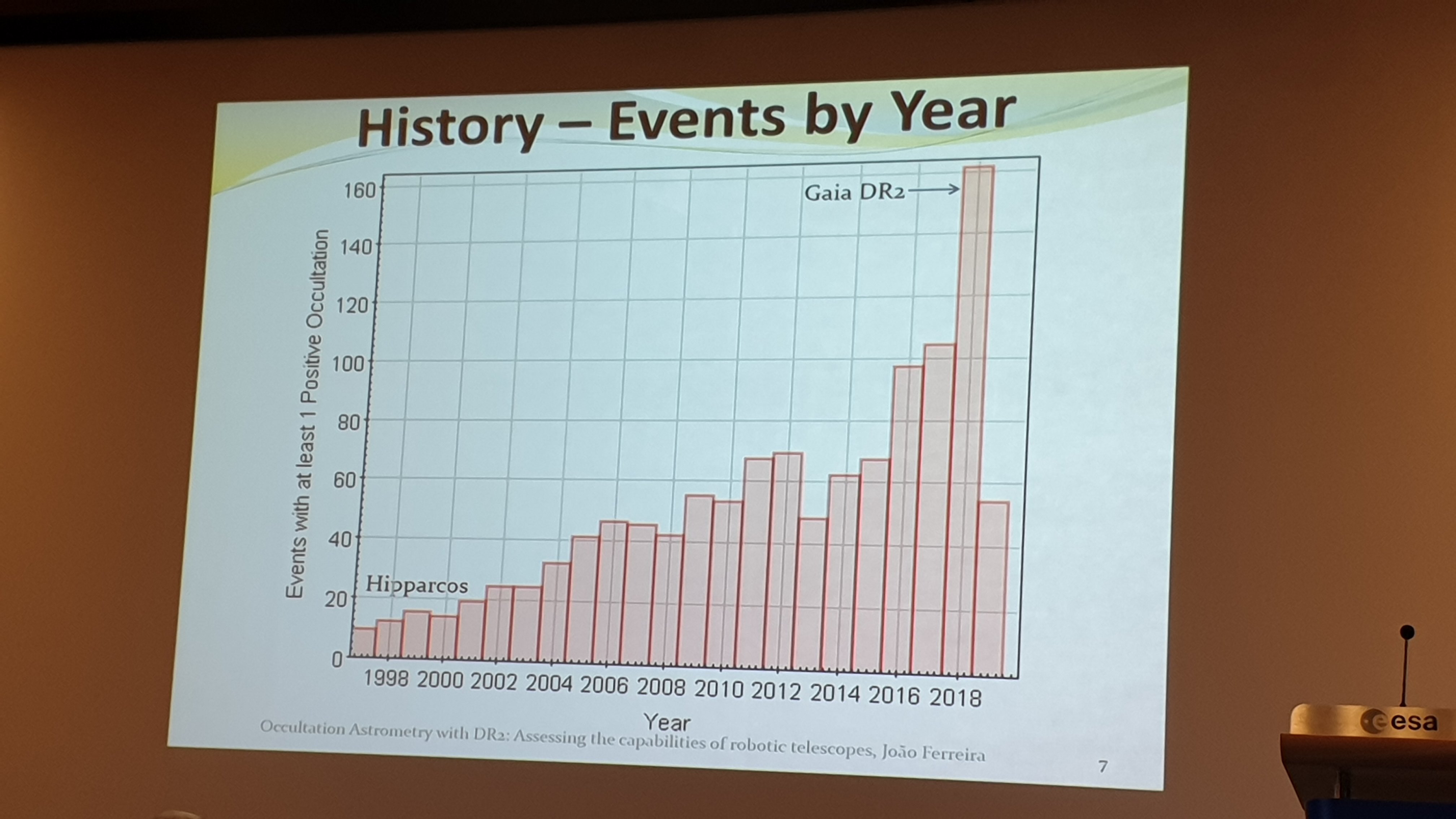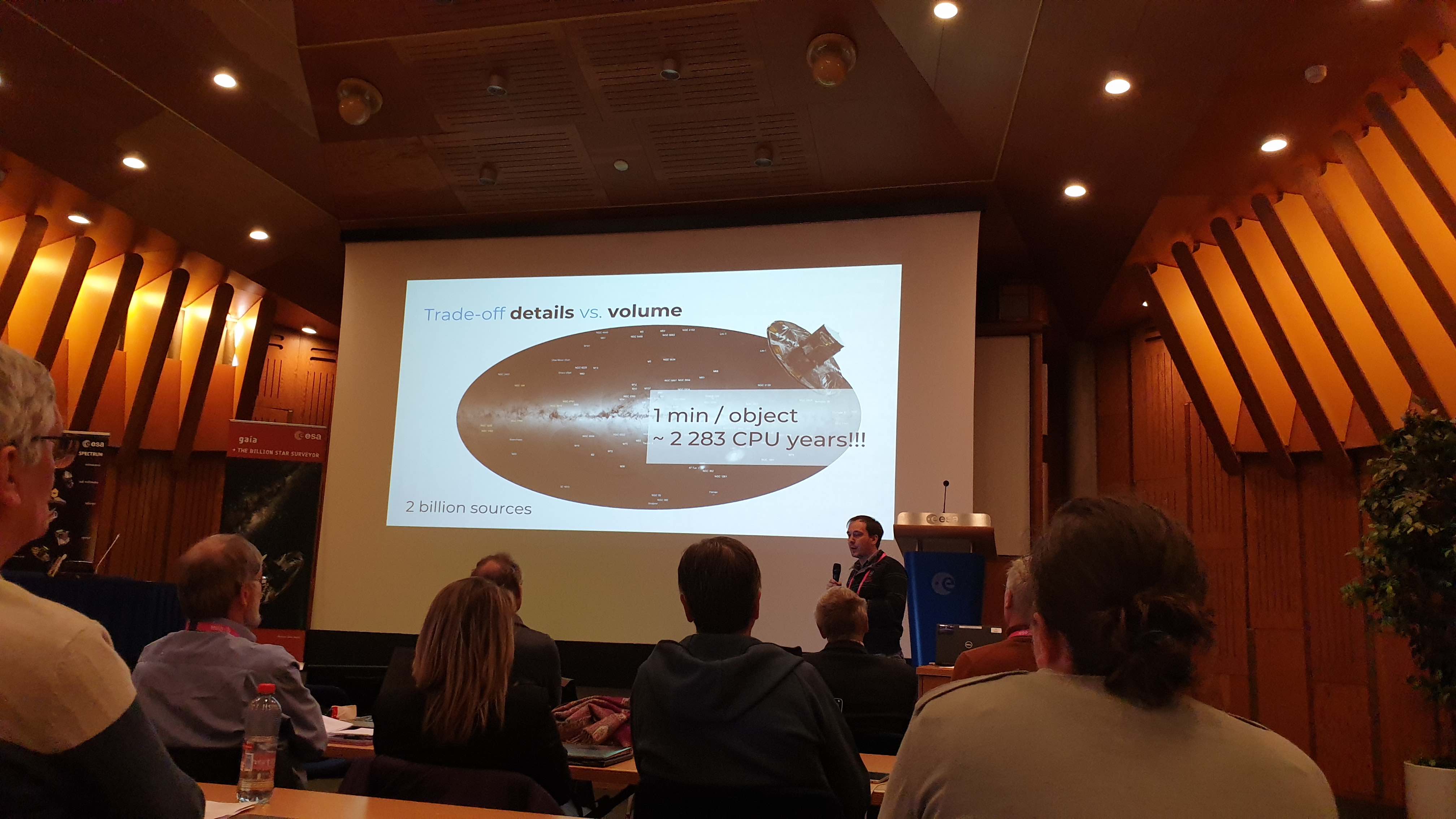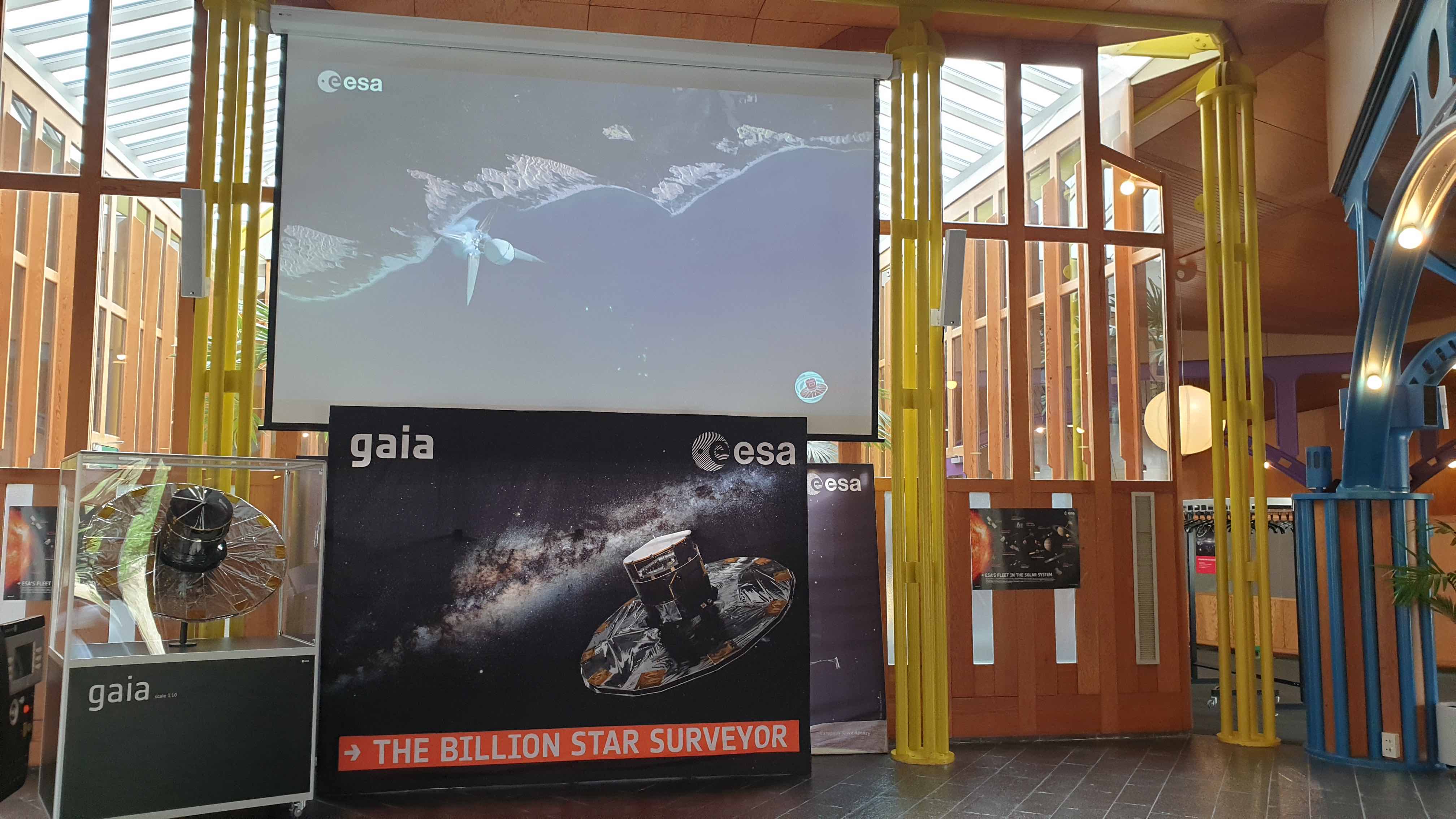IoW_20190418 - Gaia
Image of the Week |
53rd ESLAB Symposium: the Gaia universe |
|
|
|
Group picture of the participants of the 53rd ESLAB symposium "the Gaia universe" that took place from 8 to 12 April at ESTEC (Noordwijk, The Netherlands). A second group picture is available here. Image credits: ESA/Gaia/ESLAB53 |
|
The impact of Gaia data on the various fields of astronomy was evident from the many talks at the 53rd ESLAB symposium "the Gaia universe" which took place last week at ESTEC (Noordwijk, The Netherlands). Suitably timed one year after Gaia Data Release 2, the symposium was the perfect opportunity to make a status overview of the use of Gaia data. Topics ranging from kinematics of the Milky Way to stellar occultation studies and from the formation of stars to variability and quasars, Gaia data influences many, many areas.
Participants at the 53rd ESLAB Symposium "the Gaia universe". Bringing together astronomers from all disciplines and from all over the world for a week's immersion of Gaia science results, allowing scientists to look outside their specific field and learn about the advances in other fields as well, resulted in a very nice conference with a great atmosphere amongst participants.
The symposium was kicked off with a welcome from Arvind Parmar, head of the Science Support Office at ESTEC, and an overview of the status of the Gaia mission by Timo Prusti, Gaia Project Scientist, explaining that Gaia is currently in its nominal mission phase but will move to its mission extension in July this year. A mission extension has been granted for Gaia to the end of 2020 and an indicative extension is in place until the end of 2022. The Gaia space telescope is in good health and the expected lifetime for the spacecraft with current scanning mode is end-2024, when the cold gas to maintain the very stable scanning mode runs out. Kinematics of the Milky Way and the structure of the Galactic disk and bar are some of the topics of Monday. Cristina Chiappini’s invited talk discusses how Gaia brings the Milky Way into focus. Mapping the velocities can show many features like the signature of the Galactic warp and substructures in the solar neighbourhood. Others discuss the hunt for stellar streams, with many new ones discovered since Gaia DR2, and the power of the combination with other surveys which shows for example the probable imprint of the bar when combining Gaia and APOGEE and spiral structures when combining Gaia with VLBI and 2MASS. Tuesday starts of with quasars and Ludovic Delchambre discusses multiply-imaged quasars with a conclusion that 10 out of 54 known quadruply-imaged quasars were discovered using Gaia DR2. Robin Geyer, member of Gaia DPAC's coordination unit 3 responsible for astrometric processing, explains that seeing the imprint of a gravitational wave from Gaia data will be difficult. If possible, the frequencies covered would nicely complement other missions like LISA.
Robin Geyer explaining what Gaia could do for the gravitation waves research field.
To white dwarfs Gaia has been a true revolution. Pier-Emmanuel Tremblay reviews the white dwarf cooling track, while others discuss white dwarf catalogues created. The white dwarf sample is now thought to be complete within 100 pc from the Sun thanks to Gaia data. Expected number of Gaia white dwarfs is about 400,000 within 400 pc (find here some catalogues on white dwarfs). The 53rd ESLAB symposium truly covers many areas of astronomy, and thus on Tuesday, also variability results are discussed. Berry Holl, Gaia DPAC member active in Coordination Unit 7 responsible for variability processing, shows end-of mission goals and the progression to be expected from future Gaia releases. He also discusses some details on how to use the data on variability in Gaia Data Release 2, which we will dedicate an image of the week to soon. Tuesday continues with Gaia's use for determining distances to black holes, planetary nebulae and the rare ultra hot massive Wolf-Rayet stars. On the left, Berry Holl discusses the prospects for variability processing for future Gaia data releases. On the right, in an image tweeted by Xavier Luri of Gemma Rate's talk, we see the increase in the amount of parallaxes available for specific types of sources, in this example Gaia DR2 data increased the known parallaxes for Wolf-Rayet stars from one to about 400.
Moving to clusters and dust on Wednesday. Tristan Cantat-Gaudin discusses the use of stellar clusters to trace the properties of the Milky Way. Gaia data helps to probe for properties of specific known clusters, and at the same time, provides a treasure chest to search for new clusters using data mining techniques. Through star formation regions and 3D mapping of young stars in the solar neighbourhood, the topics on Wednesday then move to dust mapping. Several dust distribution maps are shown produced with different methods, which are interesting to compare. Some 3D dust maps created by Lallement et al. available in HDF5 format can be found here.
Clément Hottier presents dust distribution in the Milky Way and the dust map he presents with the one created by Rosine Lallement et al. (image obtained from the tweet by Jacky Faherty).
The velocity information that came available with the second Gaia data release can also be used to search for new hypervelocity stars. The search for these stars helped to identify some spurious Gaia DR2 radial velocities, for which an update has been provided through the Gaia DR2 known issues page. Peculiarities spotted by the community when doing Gaia science can in this way also be helpful with further processing for future releases. Apart from stars, Gaia's scanning leads to observations of other objects as well. Thursday was devoted to Solar System objects. Joseph Ďurech explains that Gaia DR2 was only the appetizer for the solar system objects and Gaia DR3 will be the main dish. Federica Spoto, Gaia DPAC member active in the Solar System objects processing unit (CU4), discusses the quality of the asteroid information already obtained in Gaia DR2 and the expected quality for the orbital solutions to be expected in Gaia DR3.
Federica Spoto discussing the Solar System objects processing in Gaia DPAC and the expectations for future Gaia data releases.
Next to the asteroids observed by Gaia directly, Gaia's astrometry helps out to improve stellar occultation predications and with this improves the chances for a successful stellar occultation observation. A nice result of this, which also demonstrates the power of the collaboration of missions, is shown by the results obtained for the NASA New Horizons mission. With the help from pre-released Gaia DR2 star fields, the trajectory to the Kuiper Belt object 2014 MU69 could be computed more precisely and the shape and size of the object could be constrained through stellar occultation studies.
Success rates for stellar occultation observations are clearly going up since Gaia Data Release 2, as presented by Joao Ferreira. In this way, Gaia also helps out gathering information on the shape of Solar System objects.
New insights into the formation of the Milky Way are presented by Amina Helmi, kicking off an afternoon on the stellar halo, globular clusters and galactic science. Synergies between Gaia, LISA and LSST are discussed, while the combination of current Gaia data with HST unveils stellar motions inside dwarf galaxies. The last day of the 53rd ESLAB symposium starts with an overview of brown dwarfs in Gaia by Jacky Faherty and continues with info on how to combine Gaia astrophysical parameters with other surveys and what to expect in Gaia DR3 by Morgan Fouesneau, Gaia DPAC member of Coordination Unit 8 responsible for astrophysical processing. Bessel's legacy is hounored by François Mignard, who concludes that Bessel's 1838 paper contained the first reliable parallax ever. Morgan Fouesneau discussing the complications that come into play when processing large amounts of data. Choices have to be made to compromise between details and processing times.
Anthony Brown, Gaia DPACE chair, wraps up the 53rd ESLAB symposium with a look forward to future releases. Gaia EDR3, the early release of Gaia DR3, is to be expected in the third quarter of 2020 with a wealth of astrometric and photometric data, and a release of QSOs and an update to the Gaia reference frame. In the second half of 2021, one can expect to get the full release of Gaia DR3 with, for selected subsets of objects, data such as source classifications, radial velocities, photometric variabilities, minor planets, and non-single star behaviour. An overall precision gain of a factor of 1.2 is expected for Gaia DR3 with respect to Gaia DR2 (for instance for parallax uncertainties), with a factor of improvement of 1.9 for proper motions. Both Gaia EDR3 and Gaia DR3 will be based upon the same set of 34 months of raw satellite data. Then looking further ahead to Gaia Data Release 4, an overall precision gain is expected for Gaia DR4 with respect to Gaia DR2 of a factor 1.7, with a factor of 4.5 improvement for the proper motions. The expected amount of input data to be used for the creation of Gaia DR4 is 60 months of raw science data. That is almost three times as much data compared to the amount that was used to create Gaia DR2 (22 months). The contents and expected number of sources for Gaia (E)DR3 and other releases are all dependent on succesful processing and validation, for which the work is currently ongoing in the Gaia Data Processing and Analysis Consortium for data releases EDR3 and DR3.
Anthony Brown summarising the 53rd ESLAB symposium, feeling thankful that Gaia data made such a difference to many fields in astronomy. It is warming to see so many scientists appreciate the quality of the Gaia data releases. "This would not have been possible without Gaia DR2" was an often heard sentence throughout the symposium. The content of the above story was based on the talks given at the 53rd ESLAB symposium and the images shown there. Proceedings of this symposium are accessible to anyone and are currently being gathered. By 3 June 2019, one can expect to have an almost complete overview of all talks on Zenodo. The symposium was extensively tweeted about using the hashtag #ESLAB53.
|
|
Credits: ESA/Gaia/ESLAB53 [Published: 18/04/2019] |
- Removed a total of (29) style text-align:center;
- Removed a total of (1) style text-align:left;
- Removed a total of (4) style text-align:justify;
- Removed a total of (1) style font-weight:normal;
- Removed a total of (1) border attribute.
- Removed a total of (1) cellpadding attribute.
- Removed a total of (1) cellspacing attribute.
Image of the Week Archive
- Removed a total of (1) border attribute.
- Removed a total of (1) cellpadding attribute.
- Removed a total of (1) cellspacing attribute.








































 Sign in
Sign in
 Science & Technology
Science & Technology
